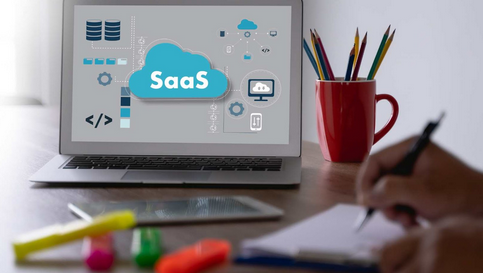Selecting the right technology stack for (Software as a Service) SaaS application development is one of the most important decisions in building a scalable, secure, and efficient product. As technology evolves, so do the frameworks and tools available for creating SaaS solutions.
In 2025, the rapidly advancing technology landscape introduces new considerations and opportunities for SaaS developers to build high-performance applications. Let’s explore the essential steps and factors involved in choosing the best tech stack for your SaaS application.

Why the Right Tech Stack Matters in SaaS Development?
Choosing a tech stack is pivotal as it determines the app’s scalability, security, and user experience—three critical factors for any SaaS product. A poor choice can lead to high maintenance costs, slow performance, and security risks.
According to a report by Statista, the global SaaS market is projected to reach $295.08 billion by 2025, underlining the growing importance of robust, scalable solutions in this sector
Factors to Consider for SaaS Applications Development
1. Understand the Requirements of Your SaaS Application
To make the best decision, first, evaluate your application’s requirements and objectives. Consider the following:
- Scalability: If your SaaS app expects significant growth, prioritize tech stacks that support horizontal and vertical scaling.
- Security: Security is essential, particularly in SaaS applications dealing with sensitive user data. Ensure that the stack offers robust security features.
- Performance: Choose technologies that deliver fast loading times and efficient handling of multiple user requests.
- User Experience (UX): Select a stack that supports smooth and responsive interfaces for an optimal user experience.
For example, if you’re building a real-time collaboration tool, you’ll need technologies that support low latency and real-time updates.
2. Choosing the Front-End Technology Stack
The front end is the part of the application that users interact with. Popular front-end technologies for SaaS applications in 2025 include:
- React: Developed by Facebook, React remains popular for its component-based architecture, which allows developers to create reusable UI components. It’s an ideal choice for SaaS apps that require dynamic user interfaces and interactivity.
- Angular: Created by Google, Angular is known for its robustness and two-way data binding, which can be advantageous for large, enterprise-grade applications.
- Vue.js: This lightweight framework is favored for its simplicity and flexibility. Vue.js is a solid choice for smaller SaaS applications or projects where rapid development is a priority.
Factors to Consider for the Front End:
- Performance: Opt for frameworks that load quickly and have a small bundle size.
- Modularity: Choose a modular framework if you plan to add features over time.
- SEO-Friendly: For SaaS applications with a web component, SEO capabilities are vital.
3. Selecting the Right Back-End Technology Stack
The back end powers the core functionality of a SaaS application. Popular backend tech stack includes:
- Node.js: Known for its non-blocking I/O operations, Node.js is ideal for real-time applications, such as messaging platforms or collaboration tools. It’s also highly scalable, making it suitable for SaaS apps with large user bases.
- Ruby on Rails: Rails is known for rapid development, which can reduce time to market. It’s a good choice for startups and smaller applications that need a robust framework without extensive customization.
- Python (Django): Django provides high-level performance with its “batteries-included” approach, offering various built-in tools and libraries. Python is often used in SaaS applications that involve data science or machine learning.
- Java (Spring Boot): Java remains relevant in SaaS due to its scalability, stability, and performance, especially for enterprise-level applications.
Factors to Consider for the Back End:
- Scalability and Performance: Choose a back-end framework that can scale efficiently as your user base grows.
- Ease of Integration: Consider frameworks that easily integrate with third-party APIs and tools.
- Community Support: Strong community support is essential for troubleshooting and access to updated libraries.
Tips: For businesses seeking a reliable SaaS Application Development Company in Canada and the USA, App-Scoop offers expertise to develop secure, scalable, and high-performance applications. Our extensive experience includes collaborations with leading companies like Social Owl, Becker Mining, and MyCare Base, reflecting our dedication to excellence and client success.
By leveraging the latest tech stacks and DevOps best practices, we create SaaS applications tailored to your needs, ensuring smooth integrations, top-tier security, and optimized performance. Contact us to transform your SaaS vision into reality with a team that values quality, innovation, and growth.

4. Selecting Databases and Data Storage Solutions
The database is critical for storing and managing data securely. Your choice of database depends on data complexity, scalability needs, and response time.
- Relational Databases (SQL): Relational databases like PostgreSQL and MySQL are reliable for structured data. They are ideal for applications that require data integrity and ACID compliance.
- NoSQL Databases: NoSQL options like MongoDB and Cassandra are preferred for handling unstructured data and scaling horizontally. They are suitable for SaaS applications with rapidly growing data volumes and complex querying requirements.
- NewSQL Databases: Emerging as an alternative, NewSQL databases, such as CockroachDB, provide SQL-like capabilities with NoSQL scalability.
- Cloud Storage (AWS, Azure, Google Cloud): SaaS applications often store large files, documents, or media. Cloud storage solutions like Amazon S3, Azure Blob Storage, or Google Cloud Storage offer reliable, scalable storage options with built-in redundancy.
Factors to Consider for Database Selection:
- Data Consistency and Integrity: For applications needing consistent data, a SQL database is often preferred.
- Query Complexity: Choose NoSQL for complex data structures and high-speed access or SQL for structured data with fewer queries.
- Scalability: NoSQL and NewSQL databases are optimized for scalability and performance with distributed architectures.
Related Articles:
5. Leveraging Cloud Infrastructure and DevOps Tools
In 2025, cloud providers offer various Infrastructure-as-a-Service (IaaS) and Platform-as-a-Service (PaaS) options, including:
- Amazon Web Services (AWS): AWS provides extensive services, from computing power to AI and machine learning capabilities, with scalability and security for SaaS applications.
- Microsoft Azure: Azure integrates well with enterprise applications and is an excellent choice for SaaS companies targeting enterprise customers.
- Google Cloud Platform (GCP): GCP excels in data services, machine learning, and analytics, making it ideal for data-intensive SaaS applications.
Using DevOps for CI/CD and Efficient Deployment
The combination of DevOps practices with Continuous Integration and Continuous Deployment (CI/CD) allows for faster releases, enhanced collaboration, and seamless updates. Popular DevOps tools include:
- Docker: Containerization through Docker ensures consistency across different development and deployment environments.
- Kubernetes: Ideal for scaling applications, Kubernetes orchestrates containers and manages microservices architecture.
- Jenkins: An open-source CI/CD tool, Jenkins automated deployment, testing, and code integration for faster development cycles.
6. Security Considerations for SaaS Applications
Security is paramount for any SaaS application, given the sensitive data it handles. Some security technologies to consider include:
- Authentication and Authorization: OAuth, OpenID Connect, and JWT provide secure methods for user authentication and authorization.
- Data Encryption: Ensure data is encrypted both at rest and in transit. Use HTTPS and SSL/TLS for secure data transfer.
- Network Security: Utilize tools like Web Application Firewalls (WAF) and Intrusion Detection Systems (IDS) to protect against cyber threats.
7. Evaluating Cost and Budget Requirements
Choosing a tech stack is not only a technical decision but also a financial one. Analyze the total cost of ownership, including development, licensing, and maintenance costs. Cloud providers often offer pay-as-you-go models, which can be more cost-effective for small-to-medium SaaS applications. Open-source frameworks can also reduce licensing costs while providing flexibility.
From the front-end frameworks that power user interactions to back-end technologies that handle data and business logic, each decision will impact the performance and longevity of your SaaS product. Utilizing cloud infrastructure and DevOps practices further enhances efficiency, security, and scalability.





